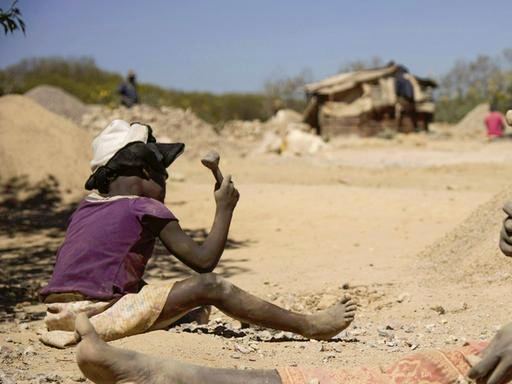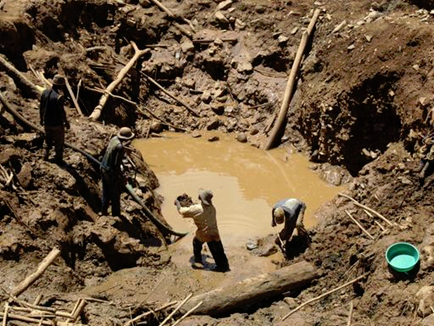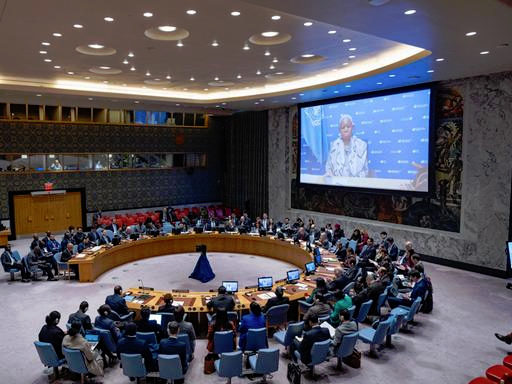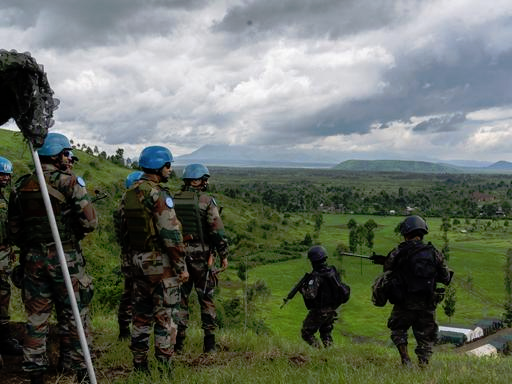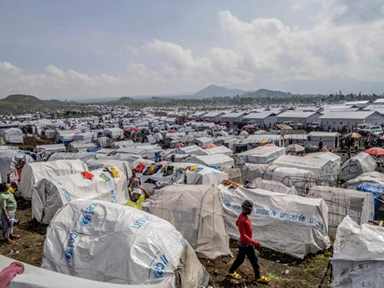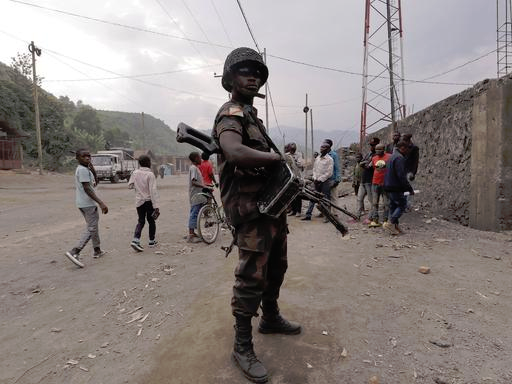fighting in eastern Congo >DCR
Source: BMZ-Germany [17 April 2025 – 23:54]
Central Africa
What the fighting in eastern Congo is about
The eastern Democratic Republic of Congo has been embattled for decades. Now the conflict between the Congolese army and the M23 rebel militia is coming to a head. What the situation in Central Africa has to do with Europe.
By Judith Raupp | 28 January 2025
A conflict has been smouldering for years between the Congo and its neighbour Rwanda: it is about mineral resources. Added to this are ethnic tensions between the Tutsi and Hutu. (picture alliance / Xinhua News Agency / Wang Guansen)
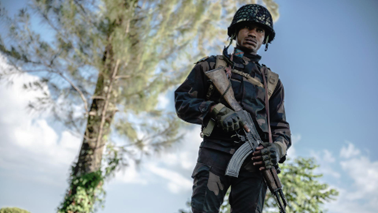
- Listen 18:54
- Download
- Copy/share link
The deadly conflict in the east of the Democratic Republic of Congo is attracting little international attention. Yet it is a source of raw materials that consumers in Germany and around the world find in their mobile phones and computers. The war threatens to destabilise the entire Great Lakes region of East Africa, home to millions of people. At the heart of the escalation is the M23 rebel militia.
Contents
- Who is fighting in eastern Congo?
- What is this conflict about?
- What role do raw materials play?
- How has the international community responded so far?
- What is the international community’s relationship with Rwanda?
- What are the consequences of the war for the population?
Who is fighting in eastern Congo?
The Mouvement du 23-Mars (M23, English: Movement of 23 March) militia has been fighting the Congolese army since November 2021. Neighbouring Rwanda and, to a lesser extent, Uganda are supporting the M23. Rwanda has stationed 4,000 of its own soldiers and modern weapons in eastern Congo.
For its part, the Congo has engaged armed forces from South Africa, Malawi, Tanzania and Burundi, as well as two private security companies from Romania and Bulgaria. In addition, the Congolese army is paying some of the 100 militias that have been operating in eastern Congo for decades to fight against the M23.
What is this conflict about?
The M23 and Rwanda accuse the Congolese government of wanting to wipe out the Tutsi. The M23 consists mainly of fighters from this ethnic group. Rwandan President Paul Kagame is also a Tutsi. In 1994, he and his militia ended the genocide against the Tutsi in Rwanda perpetrated by the Hutu.
At that time, many Hutus fled to eastern Congo for fear of revenge. Among them were perpetrators who founded the Forces Démocratiques de Libération du Rwanda (FDLR, Democratic Forces for the Liberation of Rwanda) militia and want to recapture Rwanda from Congo. The FDLR has long cooperated with parts of the Congolese army.
The roots of the conflict go back to colonial times. The Belgians once brought Tutsi from Rwanda to work as labourers in the Congo. Tutsi are traditionally cattle herders. They compete with farmers for land. Politicians, military leaders and businesspeople exploit the various population groups in eastern Congo to expand their regional power. The Congolese central government has lost control of many areas in the east. The conflict, which has been going on for decades, has cost millions of lives.

Fighting has been raging in eastern Congo for years, causing great suffering among the population. The humanitarian situation in the region around the city of Goma is catastrophic. (picture alliance / Xinhua News Agency / Wang Guansen)
Uganda and Rwanda repeatedly exploit the unstable situation to exert strategic influence. In doing so, they are sometimes rivals, sometimes allies. The current war was triggered by a military agreement between the Congo and Uganda, under which the Ugandan military was to pursue the Allied Democratic Forces (ADF) militia in the Congo. The ADF has links to Islamic State (IS) and carries out attacks in Uganda and the Congo. In addition, Uganda finances roads connecting resource-rich areas in the Congo with Uganda. Rwanda felt marginalised and activated the M23.
Uganda and Rwanda have since reconciled. However, Uganda is playing a double game. On the one hand, the country is cooperating with the Congo, and on the other, with the M23.
What role do raw materials play?
Eastern Congo is rich in raw materials such as gold and coltan. The M23 occupies the mining town of Rubaya. A large proportion of the coltan exported by the Congo comes from there. In 2019, the Congo produced around 40 percent of the coltan processed by the global electronics industry. The ore is found in every smartphone and every computer.
Some of the raw materials in eastern Congo are mined illegally and smuggled through Rwanda and Uganda, from where they officially enter the world market. Rwanda is considered a preferred transit country for coltan. Last year, Rwanda replaced Congo as the world’s largest exporter of coltan.
In December 2024, the Congolese government filed a lawsuit against Apple subsidiaries in France and Belgium. It accuses the US technology company of using so-called ‘conflict minerals’ from the Congo. Apple denies this.
How has the international community reacted so far?
The international community urged Rwanda and the Congo to find a diplomatic solution. Unlike in the first war waged by the M23 ten years ago, the UN peacekeeping force MONUSCO is not actively fighting alongside the Congolese army. MONUSCO is only providing logistical support.
During the 2012-13 war, Western countries cut their development aid to Rwanda. The Congolese army and UN peacekeepers then drove the weakened M23 into exile in Rwanda and Uganda. In 2024, the EU imposed sanctions only on individual members of the Rwandan army and the M23. Individual militia commanders who side with the Congolese army were also sanctioned.
What is the international community’s relationship with Rwanda?
Rwanda has become an important partner that the international community does not want to upset. With 5,876 soldiers and police officers, Rwanda was the second largest contributor of troops to UN peacekeeping missions at the end of July 2024. In addition, the EU has so far provided 20 million euros in funding for a Rwandan military mission in Mozambique. A further 40 million euros are under discussion. In Mozambique, the Rwandan army is fighting Islamist terrorists. Due to the terror, a liquefied gas project worth 20 billion US dollars by the French Total Group has stalled there.
In February, the EU also signed a memorandum of understanding with Rwanda, according to which the EU intends to support the development of an industry for the further processing of raw materials in Rwanda. The global industry is dependent on these raw materials.
Rwanda also plays a role in migration policy: some politicians in Europe see the country as a potential third country to which migrants can be sent for the duration of their asylum proceedings. Representatives of the FDP and CDU have also expressed similar views.
What are the consequences of the war for the population?
In August 2024, the United Nations counted 2.4 million internally displaced persons in the war-torn province of North Kivu. Despite the poor security situation, 1.5 million people have returned to their villages. Supplies in the refugee camps are inadequate. Diseases such as cholera and mpox are spreading. One third of the approximately seven million inhabitants of North Kivu cannot feed themselves adequately.
The M23 occupies agricultural areas, levies compulsory taxes and, like other militias and the Congolese military, collects money at roadblocks. Food prices in the besieged city of Goma have doubled or quadrupled, depending on the product.
Sexual violence is widespread. Armed men, including numerous Congolese soldiers and militiamen equipped by the army, raid refugee camps and rape women. The high level of militarisation in Goma is also leading to increased crime. The city’s citizens’ association recorded two to three robberies every day in July.
In May, a refugee camp was bombed. More than 30 people, mostly women and children, were killed. The attack is attributed to the M23. The Congolese army maintains a base next to the camp where the refugees are seeking protection.
People in the areas occupied by the M23 live in constant fear that their villages could be hit by bombs. They also report that the M23 sometimes loots and kills anyone they consider to be a collaborator with enemy militias or the army. The human rights organisation Human Rights Watch accuses the M23 of deliberately killing civilians.
